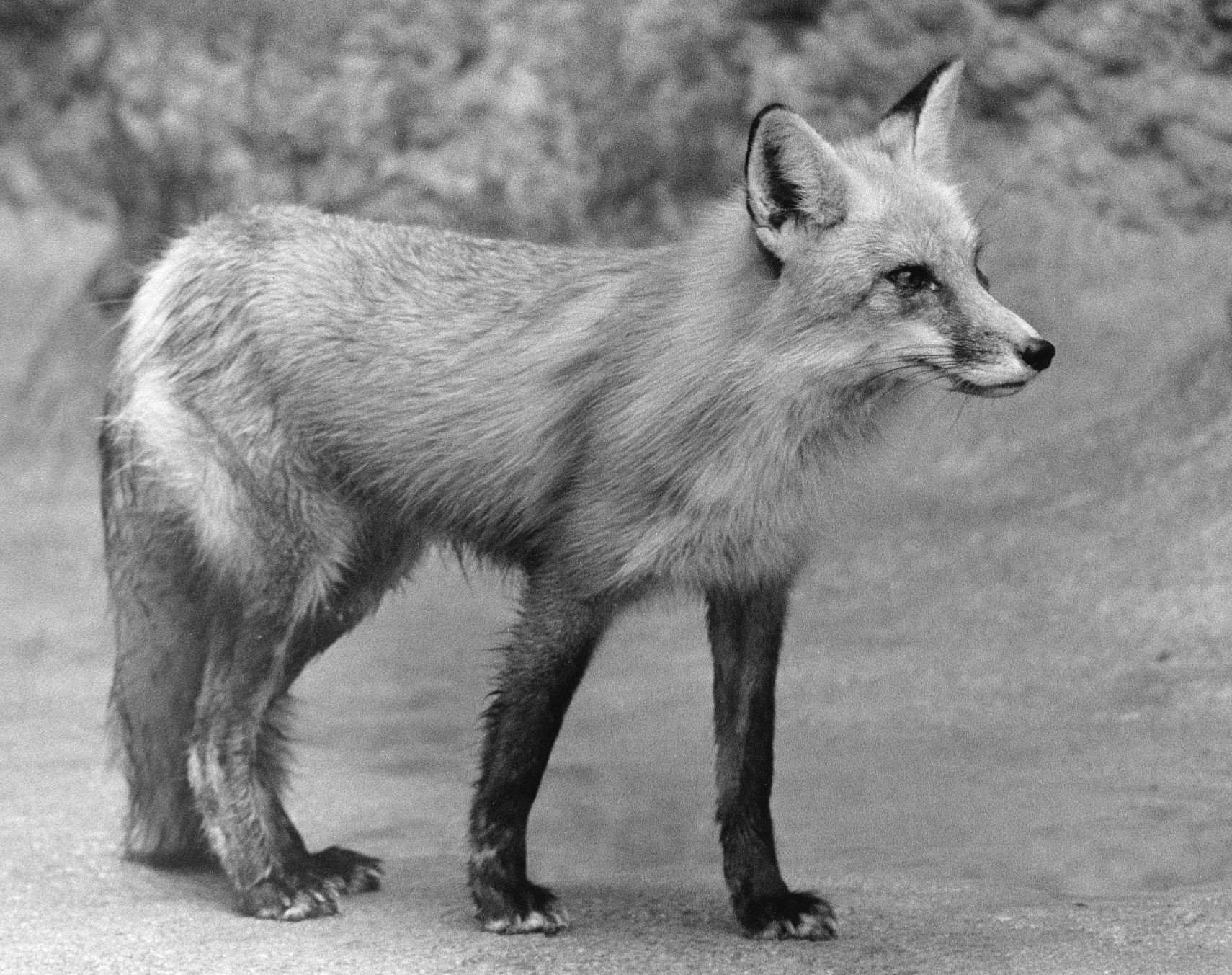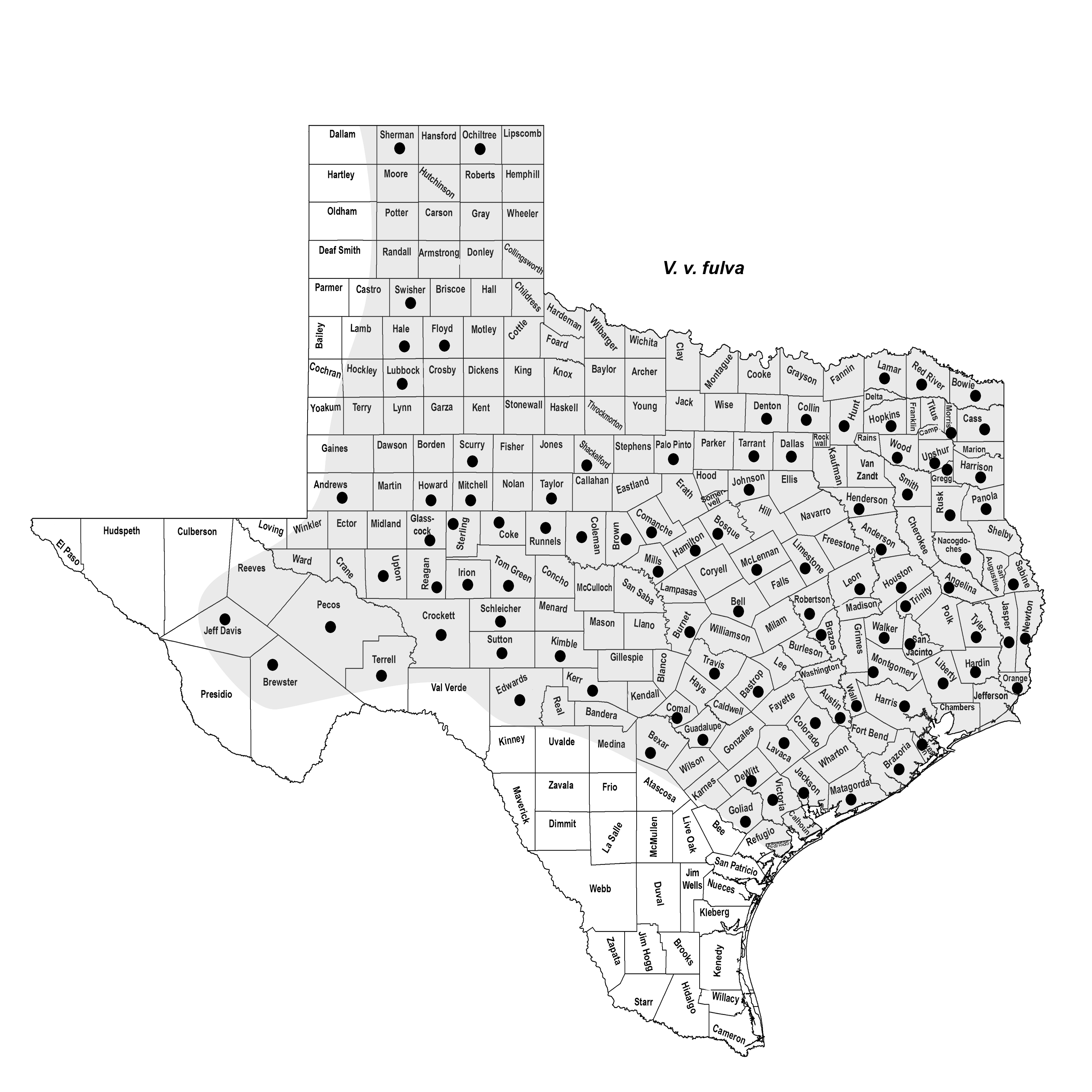RED FOX*
Vulpes vulpes (Linnaeus 1758)
Order Carnivora : Family Canidae
*Introduced species
DESCRIPTION. Similar in size to the gray fox but conspicuously different in color and in cranial characters. Considerably larger and more reddish than the swift or kit fox. Tail a thick bush, circular in cross section, and white tipped; face rusty fulvous, grizzled with white; upperparts bright golden yellow, darkest along middle of back; chin, throat, and midline of belly white; forefeet and legs to elbow black; black of hind feet extends as a narrow band along outer side of leg to thigh; backs of ears black. Several color phases: cross, black, silver, Sampson, and the normal red. Young foxes duller in color than adults. Dental formula: I 3/3, C 1/1, Pm 4/4, M 2/3 × 2 = 42. Averages of external measurements: total length, 972 mm; tail, 371 mm; hind foot, 163 mm; females average slightly smaller than males. Weight, 3–5 kg.

DISTRIBUTION. Red foxes are not native to Texas, having been introduced for purposes of sport around 1895 in the eastern and central parts of the state. Today, they occur over most of the state except for the far western and southern regions.

SUBSPECIES. Vulpes v. fulva.
HABITS. Their favored habitat is mixed wooded uplands interspersed with farms and pastures.
Vegetative types containing brush and a ground cover of grasses and sedges also are
heavily used. Thus, they seem to select diverse areas that support a mixture of vegetative
components and avoid large homogeneous tracts of any single type.
Red foxes are social. The family unit is composed of the male and female (called the
vixen) plus their young of the year. Adult foxes are thought to remain in the same
area for life. The size of their home range varies with terrain, complexity of the
habitat, and food supply.
Red foxes are most active at night, with a tendency toward crepuscular activity. Activity peaks typically correspond with peaks in prey activity. They often travel the same routes, which may become worn into trails.
The major food items of foxes are small rodents, rabbits, wild fruits and berries, and insects. They are opportunistic feeders and take any acceptable food in proportion to its availability. When hunting for mice, the fox stands motionless with tail arched stiffly to the rear, ears erect, listening and watching intently. The capture or attempted capture is executed by a leap in which the stiffened forelegs are brought down sharply. There may be frantic striking with the feet and searching with the nose as the intended victim attempts to escape.
Female red foxes have a single estrous period each year. Males and females pair off and mate from late December to January or February and reputedly remain mated for life. Females have a very short period of heat that lasts only 2–4 days. The pups, which may number anywhere from 1 to 10 (average 4–6) are born in March or April following a gestation period of about 53 days.
The female establishes the den site for the young in late winter, but both parents live together while raising the young. Foxes either dig their own dens or utilize those of other burrowing animals. Sometimes two litters may occupy a single den. Pups first open their eyes at 9 days of age, appear outside the den at about 1 month, and are weaned at 8–10 weeks. Both parents may bring solid food to the den for the pups. The family unit remains together until early fall, when the young are full grown and dispersal occurs. After dispersal, foxes remain more or less solitary until they pair and travel together during the mating season.
The life expectancy of a pup in the wild is <1 year, and few foxes live beyond the age or 3 or 4 years, particularly in areas where they are hunted and trapped heavily. Humans and domestic dogs are their major predators, although pups may be lost to great horned owls and other predators. Red foxes are susceptible to a variety of diseases, including rabies, distemper, and infectious canine hepatitis.
The red fox ranks low among furbearers in numbers of individuals harvested. The most important ecological regions for harvesting red foxes are the Pineywoods, Cross Timbers and Prairies, Edwards Plateau, and Rolling Plains.
POPULATION STATUS. Introduced, common. This introduced fox has done remarkably well in Texas, having expanded to cover most of the state except for the far western and southern regions, although they do not seem to be abundant anywhere, as is the case with most carnivores.
CONSERVATION STATUS. The IUCN lists the red fox as a species of least concern. Red foxes do not appear on the federal or state lists of concerned species.
From The Mammals of Texas, Seventh Edition by David J. Schmidly and Robert D. Bradley, copyright © 1994, 2004, 2016. Courtesy of the University of Texas Press.
Natural Science Research Laboratory
-
Address
Museum of Texas Tech University, 3301 4th street, Lubbock, TX 79409 -
Phone
806.742.2486 -
Email
nsrl.museum@ttu.edu

